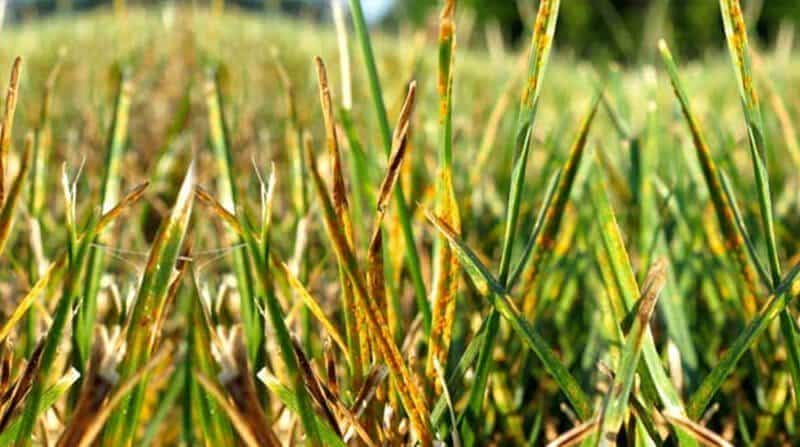Lawn Rust Disease is very is a pretty common fungal disease that is generally most visible in the late Summer into early Autumn.
While it can disfigure your lawn if left to spread, the good news is that it can be remedied fairly easily.
What is Lawn Rust Disease?
Lawn Rust is one of the oldest diseases to attack turf grasses, usually later in the summer and early autumn when temperatures are moderate.
What Causes Lawn Rust Disease to Develop?
Rust is a fungal disease caused by several fungi.
Unlike other fungal diseases like Dry Patch or Fairy Rings, it doesn’t grow in soil or the thatch layer.
Instead, it attacks living grass leaves, most often when it’s wet and the grass is stressed and lacking in Nitrogen. Usually after drought conditions.
What Does Lawn Rust Look Like?
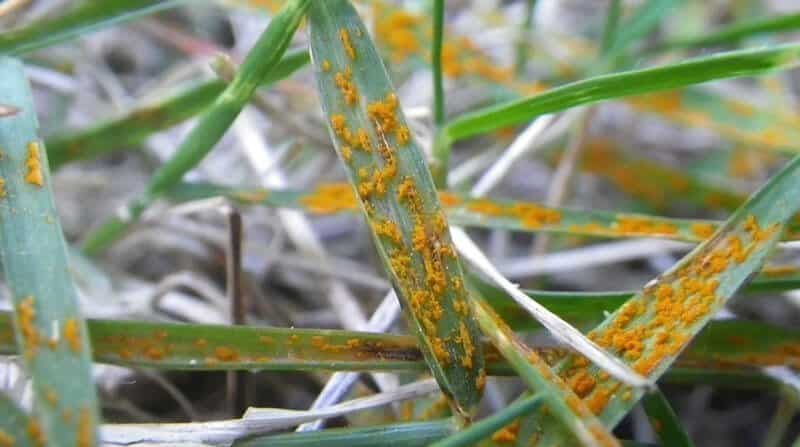
You’ll notice your lawn turning a yellow/orange colour.
This is the colour of the spores that break through the blades of grass.
On closer inspection, you’ll see the spores are powdery and easily rub off the blades of grass. Rust produces spores in massive numbers with each spore being capable of starting a new leaf infection.
They are spread very easily either on the wind or by cross-contamination. You may notice it on your hands or shoes and clothes if you’ve been working on your lawn.
Problems Caused By Lawn Rust
Grass grows through the process of Photosynthesis which is the process of using sunlight as the energy to create and store food.
Each blade of grass is like a solar panel that’s used to trap light for the purpose of photosynthesis.
However, when the grass gets covered in fungal spores, they block the sun from reaching the grass, taking away its energy source. Now the grass is unable to produce food and so growth is stunted.
And where grass can’t grow, other things will, like moss and weeds as well as other diseases.
How to Cure Your Lawn of Rust Disease
Fortunately, Lawn Rust is easily cured.
There are no pesticides available to kill it so it all comes down to the application of good lawn care practices;
Here’s how to sure your lawn of Rust Disease;
Step 1: Apply a High Nitrogen Fertiliser
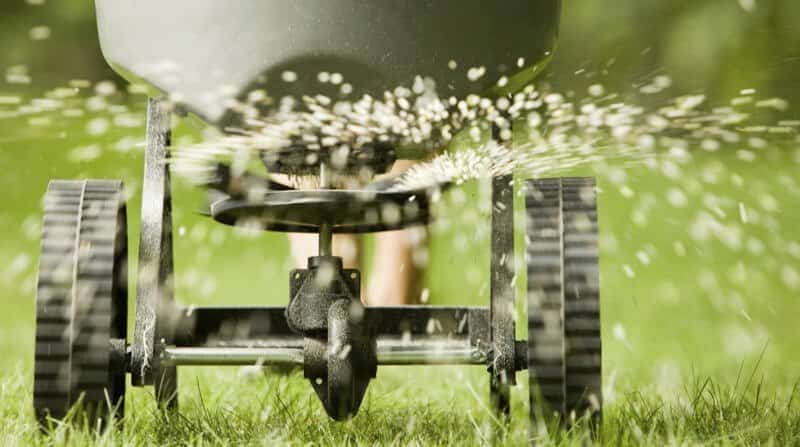
As I said earlier, Lawn Rust attacks grasses are deficient in Nitrogen so your first step should be to get it back into the soil.
Applying a fertiliser will give the grass a boost of Nitrogen, encouraging it to grow.
A spring/summer fertiliser is perfect for use up until the end of August. Once you get into September, use an autumn fertiliser.
I prefer to use a granular fertiliser for this. Read this article for advice on buying the right fertiliser.
Step 2: Cut the Grass

The application of a fertiliser containing Nitrogen will cause the grass to grow.
So cut the grass, not taking any more than a third of its length. Wait for 5 days and mow again. Then wait for another 5 days and mow the lawn again.
Doing this will mean the disease is mowed out of the lawn (as long as you remove the clippings!)
How to Prevent Lawn Rust From Developing
As I have said, Lawn Rust Disease usually develops in weakened grass, often after periods of drought.
The following treatments, done as part of your lawn calendar will prevent it from attacking your lawn;
Mow the Lawn Regularly
This cannot be stressed enough.
Cutting the grass regularly (and correctly) is by far the most important part of maintaining a healthy lawn.
With regular cutting, the grass can’t grow upwards so is forced to grow sideways, creating new roots, shoots and leaves.
Grass leaves are like solar panels that trap sunlight which it uses to create and store food. The more grass in the lawn, the healthier and more resistant to diseases it will be.
Aerate in Spring and Autumn
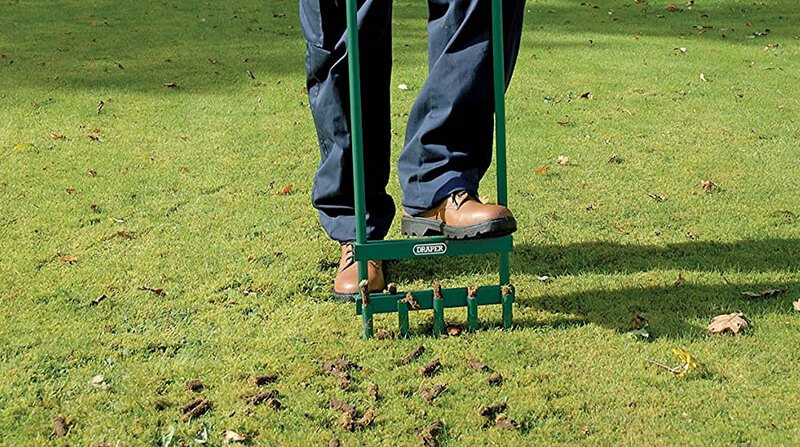
Lawn aeration improves drainage into the soil.
By spiking your lawn with either a garden fork or aeration sandals as part of your spring lawn care and again in the autumn, you create holds for water, air and moisture to penetrate the soil.
And by hollow-tine aerating in the autumn every year or two, you’ll remove cores of turf which relieves soil compaction. This, in turn, improves drainage.
Fertilise in the Spring and Autumn
To prevent Lawn Rust you must keep Nitrogen levels in the soil topped up.
The best way to do this is to apply a slow-release spring/summer fertiliser in the spring, around April or May time is perfect. Then apply an autumn fertiliser in September.
If needed, apply a liquid fertiliser in between to keep Nitrogen levels topped up. Liquid fertilisers tend to be very high in Nitrogen so don’t apply them in drought conditions as you could scorch the grass.
Water Your Lawn During Hot Weather
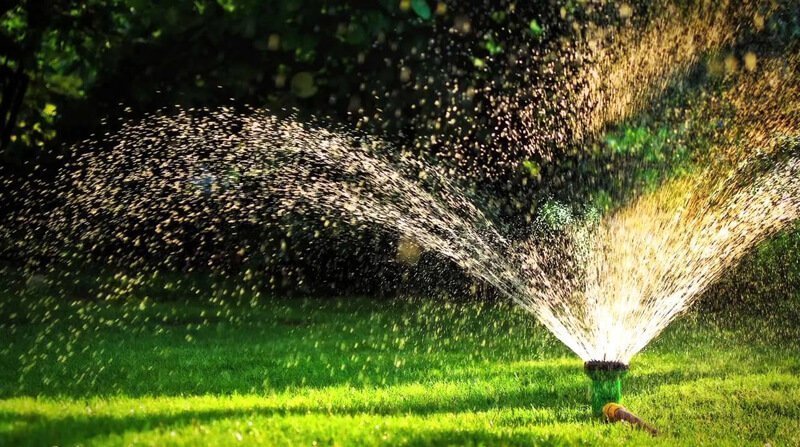
Watering the lawn is a very simple thing, yet many lawn owners get it wrong.
For a lawn to remain healthy, the soil needs 1-2 inches of rain each week.
Many lawn owners give their lawns a light sprinkling with the garden hose in the evenings. This causes more problems than it solves.
Here’s why…
A light sprinkling of water will only sit on the blades of grass. Grass cannot consume water through it its leaves, it can only absorb it via its roots. For that to happen, the water must be able to penetrate the soil.
Not only that, but surface moisture is the perfect breeding ground for fungal diseases like Lawn Rust, Snow Mould and Pink Patch to take hold. Watering in the evening means this surface moisture will sit there all night, giving the fungus lots of time to develop and take hold.
So the best way to water your lawn is to water it deeply, once a week in the morning. This will mean the water can penetrate the soil and the day’s sun can dry the surface moisture.
To measure how much you’ve watered, put a little tray on your lawn and when it’s got 1-2 inches of water in it, turn the tap off.
It’ll take about an hour.
Reduce Shade and Improve Air Flow Around Your Garden
This is easier said than done because often times shade is cast and airflow is reduced by buildings or permanent structures.
That said, if you can do any of the following, it will help to reduce the amount of moisture lying on the surface of your lawn.
- Remove low hanging branches from any trees – Try and remove any low hanging branches from trees and keep them at least 3ft off the ground. This will allow more light into the area.
- Prune thick bushes and hedges – Doing so will improve airflow through them and let in more sunlight.
- Replace fencing – This is on the extreme side but if you’ve done the above and your lawn still suffers from disease caused by surface moisture, try replacing your solid fence panels for slatted versions. This will let more air and light onto your lawn.
In Conclusion
Lawn Rust Disease is common and it looks unsightly.
All that being said, it’s an easy problem to fix and prevent. It’s just a simple case of good lawn care practices.
Over to You
Do you have Lawn Rust in your garden? If so, how are you going to fix it?
Have you had it in the past?
Any and all questions, comments and suggestions are welcome in the comment section below.
